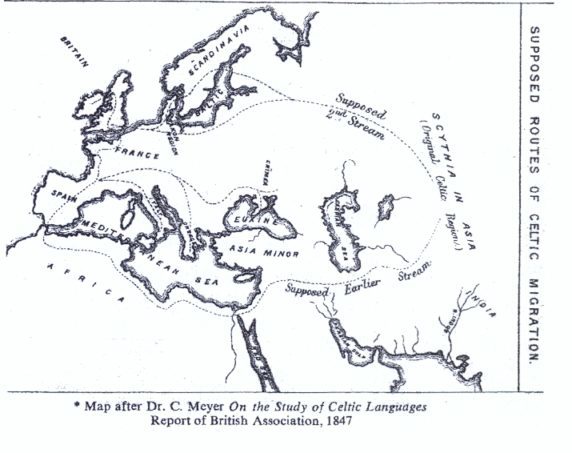DID YOU KNOW THESE FACTS?
National Message 1956
THE leading branch of the true Kelts or Celts were known as the Cymry (pronounced Kumri).
WHERE DID THE CYMRY COME FROM?
At what time, or from what quarter, the cimbri (Cymry) came first to Britain it is impossible to ascertain. For the Celtic race, in their westward progress from Asia, Meyer* assigns two principal routes, and along one or other of these, and perhaps chiefly by the northern (if credit is given to the declarations of the Triads), the Cymry made their way to their final home. Meyer listens to the intimations, slight as they may be, of history, but mostly relies on the abiding footprints discovered in local names. He traces one route through Syria and Egypt, along the northern coast of Africa, across the Strait of Gibraltar, and through Spain to Gaul, where it separates into three branches, one terminating in the British Isles, the other in Italy, and the third near the Black Sea. The other great stream of migration ran less circuitously and more northwards, through Scythia in Europe, the shores of the Baltic Sea, Scandinavia or Jutland. Prussia (the supposed Pwyl of the Welsh Triads), through Northern Germany. the plains of the Elbe (the region of the Saxons), and to Britain across the German Ocean, the ‘hazy sea’, (Mor Tawch) of the Triads. It is conjectured, moreover, that the stream which came by Africa and Spain was the earliest to reach Britain. They may have been the Gaels. The two routes are roughly represented on the annexed sketch map.
Whatever the origin of the name Cymry, and whencesoever the people, it is obvious from the whole tenor of their history that they had from early times obtained a commanding position among the other Celtic tribes of Britain. They seem, by pre-eminence, to have been called by the old ancestral name, Cimbri (Cymry) – a place of distinction must be accorded the Cymry as the strongest,and most persistent in maintaining language, race, and territory, of all their brethren.’–The Pedigree of the English People, pp. 34, 35. Thomas Nicholas, M.A., Ph.D., F.G.S. Fifth edn.
WHEN DID THEY ARRIVE AND HOW WERE THEY DESCRIBED?
‘Philology teaches that Keltic speech was unknown in these islands before the seventh century B.C….The first Keltic-speaking population of Britain were no doubt racially mixed, but the dominant strain corresponded to descriptions of the Kelts by ancient and modern authorities, being tall and fair.’-A Guide to the Antiquities of the Bronze Age, British Museum, 2nd edn., pp. 13, 14.
WERE THEY RACIALLY AKIN TO THE SAXONS WHO FOLLOWED THEM INTO THESE ISLANDS?
From the physical point of view, the Kelt and Saxon are one: whatever be the source of their mutual antagonism it does not lie in a difference of race. It is said that we British are a mixed and mongrel collection of types and breeds; the truth is, that as regards physical type, the inhabitants of the British Isles are the most uniform of all the large nationalities of Europe.’-Sir Arthur Keith, see pp. 22-26 Nalionality and Race etc. Robert Boyle’s Lecture 1919.
WHAT WAS THE CONTEMPORARY NAME IN THE ASSYRIAN RECORDS FOR THE PEOPLE OF THE NORTHERN KINGDOM OF ISRAEL? (which was not composed of Jews and which became pagan) and whom the Assyrians carried captive from Palestine to Media near the Caspian Sea in the 8th century B.C.
‘The Northern Kingdom was the land or house of Chumri or Chumria, the Southern, the land of Yahuda or Yaudi (Judah-Jews) to the Assyrian invaders of Israel and Judah.’-Vol I, part 11 Smith’s Dictionary of the Bible, new edn. p. 1308 note f.
End


